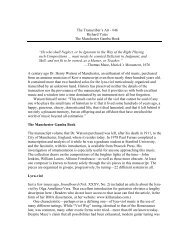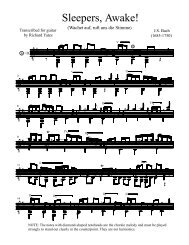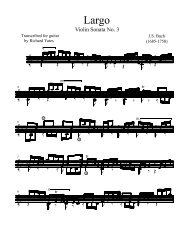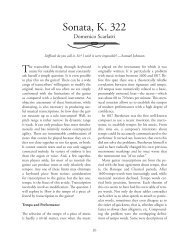Matthaeus Waissel's Lute Tutorial - Sarge Gerbode's Lute Page
Matthaeus Waissel's Lute Tutorial - Sarge Gerbode's Lute Page
Matthaeus Waissel's Lute Tutorial - Sarge Gerbode's Lute Page
Create successful ePaper yourself
Turn your PDF publications into a flip-book with our unique Google optimized e-Paper software.
A thorough and full instruction<br />
on lute tablature and fingering<br />
On lute tablature<br />
Tablature consists of two things: [symbols for locations on] the fingerboard [Lautenkragen] and<br />
rhythm notations [mensur].<br />
On the Fingerboard<br />
The lute is commonly strung with six strings, of which the coarsest is called the Great A or the<br />
great bombard [Bomhart]. Then there follow five more strings: The first is called the Prima, the<br />
second Secunda, the third Tertia, the fourth Quarta, and the fifth Quinta. And on the fingerboard<br />
are eight frets, and these are designated under each string with letters. The great bombard has its<br />
own series of capital letters, and these go lengthwise from top [closest to the nut] downwards,<br />
from B to J. The other five strings also have their letters, the whole lower case alphabet a b c to z<br />
There are two additions from Latin script, 7 and 9, so that the fifth fret may be complete.<br />
However, because three frets are left over, the same small letters are repeated from the beginning<br />
to p, but distinguished by a dash over them, so they may be differentiated from the others. These<br />
lower-case letters don’t go down lengthwise [from the nut] as the upper-case notes go under the great<br />
bombard, but [crosswise] along the frets. Where these upper- and lower-case letters are placed in the<br />
tablature, you must finger them with the left hand, each in its own place, according to the skill of<br />
[correct] fingering. Further, the A with which the great bombard is indicated or symbolized and the<br />
five numbers which designate the other five [open] strings―each of which has its own name,<br />
namely: 1 2 3 4 5―this A and the five numbers are written on the belly of the lute under the<br />
fingerboard, each under its own string. And when you see them in the tablature, you must not stop<br />
them with the left hand but they must only be plucked open with the right hand.<br />
This is a quick and simple instruction for the first part of tablature, namely the fingerboard: how the<br />
same, with its notes and numbers, is described and how one stops the notes. The [strings<br />
corresponding to] A and the numbers are not played stopped, but open, sometimes alone and<br />
sometimes together with various [other] notes (that need to be stopped).


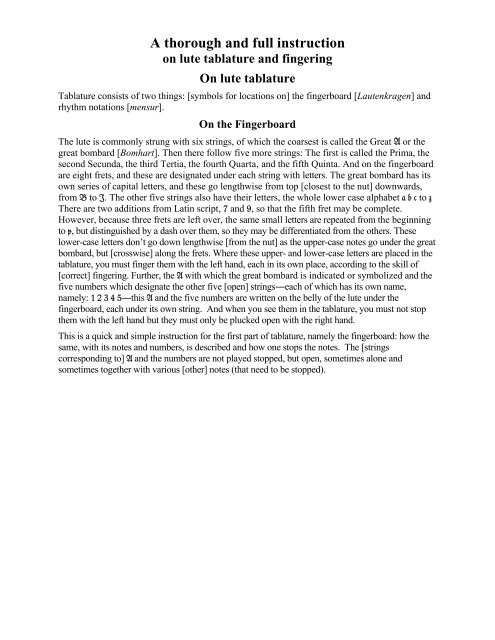

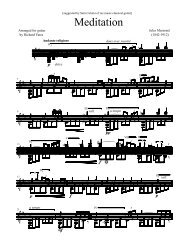
![Finale 2005b - [BWV846-Prelude in C.MUS]](https://img.yumpu.com/43978887/1/190x245/finale-2005b-bwv846-prelude-in-cmus.jpg?quality=85)
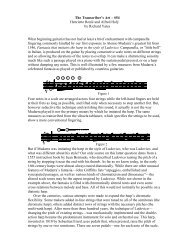
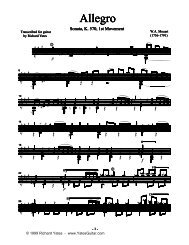

![Finale 2005b - [AirG-TAB.MUS] - Richard Yates Classical Guitar ...](https://img.yumpu.com/37104901/1/190x245/finale-2005b-airg-tabmus-richard-yates-classical-guitar-.jpg?quality=85)

